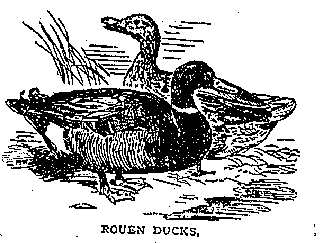Rouen duck

The Rouen is a heavyweight breed of domesticated duck raised primarily for decoration, exhibition[1] or as general purpose ducks, since they are not prolific egg layers. Rouen ducks are frequently used for meat.[1] The breed originated in France sometime before the 19th century.
Description
The plumage coloring of both the Rouen drake and the Rouen hen are nearly identical to that of the Mallard drake and Mallard hen. The Mallard color pattern is referred
to as gray.[1] Males have green heads, white collars, black tail coverts and dark, ashy brown tail feathers,[2] a gray body, and a deep claret breast. The female Rouen hens are a consistent shade of mahogany brown, with a brown crown and tan eye-stripes extending from bill to the back of the eyes. Another feature of the female color pattern is the distinct, detailed penciling found on feathers of the head, neck, body, body, most of the wing and tail.[2] Rouen hens can be much darker brown than Mallard hens. Both sexes also have blue speculum feathers. However, Rouen speculum feathers are brighter in color and larger in size than that of the Mallard. Adult Rouen ducks are typically significantly larger than Mallard ducks. The Rouen duckling is identical to the Mallard duckling in terms of plumage coloring. In North America, two distinct types are bred: the common, or production-bred, variety that is larger than a Mallard but has a typical duck conformation, and the much larger and squarer standard-bred variety. The production variety normally weighs 6–8 lbs (2.7–3.6 kg) while the standard-bred weighs 9–12 lb (4.1–5.4 kg).
Rouen ducklings can be distinguished from wild mallard ducklings by the presence of a second stripe which runs across their face, just under their eye, whereas mallard ducklings have only one stripe which runs across their eye.
History
The breed was first raised in France, but it was not until it reached England in the 19th century that it was refined into the breed recognized as the Rouen today. The French version resembled a larger than average Mallard, but by selective breeding the British developed the exhibition-type Rouen.[1] The final product was a bird with a deep, long keel, boat-shaped profile, enormous appearance and refined markings, especially the penciling on the female.[1] It was used chiefly as a roasting bird; though it produced 35 to 125 eggs a year, there were other breeds which were more reliable egg-layers with higher production. The eggs are typically white, but can have blue and green tints. Exhibition-typed Rouen ducks have been known to crush their eggs if allowed to set due to their massive frames.[1] In 1861, Mrs Beeton said of it:
| “ | The Rouen, or Rhone duck, is a large and handsome variety, of French extraction. The plumage of the Rouen duck is somewhat sombre; its flesh is also much darker, and, though of higher flavour, not near so delicate as that of our own Aylesbury. | ” |
The origin of the name is not known. When they arrived in England, they were variously called Rhône, after the region in southwest-central France, Rohan, after the cardinal of that name, Roan, for the mixture of colours, and Rouen after the northern French town, with Rouen eventually being adopted in both England and France. In France they are called Rouen Foncé (dark) as opposed to Rouen Clair, which are lighter in colour.
In 1850 the first Rouens were introduced to the USA by D. W. Lincoln of Worcester, Massachusetts, and used as general farm ducks until becoming popular as show birds. They were included in the Standard of Perfection of the American Poultry Association in 1874 and since then have won many titles, often having the most entries in the heavyweight class and doing well in competition with other breeds.
See also
References
- 1 2 3 4 5 6 Holderread, Dave (2001). Storey's Guide to Raising Ducks. North Adams, MA, USA: Storey Publishing. pp. 83, 84, 85.
- 1 2 American Poultry Association Standard Revision Committee; Malone, Pat; Donnelly, Gerald; Leonard, Walt (2001). American Standard of Perfection 2001. USA: American Poultry Association. pp. 308, 309.
- Holderread, Dave (1978). Storey's Guide to Raising Ducks. Storey. pp. 82–85. ISBN 1-58017-258-X.
- Mrs.Beeton (1861). The Book of Household Management.